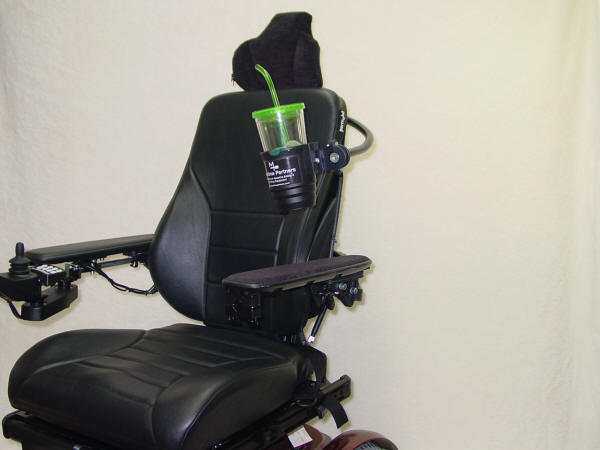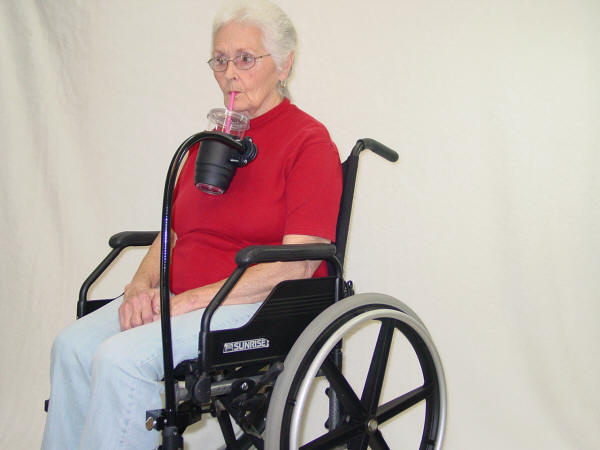Mealtime Partners, Inc.
Specializing in Assistive Dining and Drinking Equipment
April 2017 Independent Eating and Drinking Newsletter

|
April Topics:
|
||
|
Mealtime Partners Home Page Send a Comment or Suggestion |
|||
| Subscribe to Newsletters |
This article will discuss calories, and how people who have disabilities are impacted by their calorie intake.
Most people in the United States understand the term calorie as it relates to food and drink. However, the definition of calorie is employed differently depending upon whether it is used in a medical or scientific application. Regardless of the application, a calorie is a unit of energy. Many dictionaries have the first definition of calorie as, “the amount of energy required to raise the temperature of a gram of water 1-degree Celsius at sea level”. (In some areas of the world, including the European Union and Australia, instead of using the term calories, joules is used. One calorie is equal to 4.19 joules. If you see a food label from a product made in Europe it will have the number of joules per serving on it.) Calorie, as used to describe food, is an abbreviation of kilocalorie, thus there are two types of calories:
-
A small calorie is the amount of energy requires to raise one gram of water by one degree Celsius and,
-
A large calorie is the amount of energy required to raise 1,000 grams of water by one degree Celsius.
In other words, a large calorie is 1,000 times bigger than a small calorie and food labels use the term calorie to describe a large calorie.
When we discuss calories in relation to food and drink almost every item that is consumed, whether liquid or solid, is made up of calories; the exceptions are things like water and some diet foods that have low, or no, calories. We consume calories and they provide our bodies with energy that we burn to live. Not all foods provide the same number of calories per gram. For example: 1 gram of fat contains 9 calories while 1 gram of protein and 1 gram of carbohydrates have 4 calories. Most foods are made up of a mixture of fat, protein and carbohydrates; therefore, what we eat will determine the number of calories we consume. To function at its best, our bodies need a range of nutritious foods that include whole grains, fruits and vegetables, protein (meat, fish and legumes), fats and oils, and dairy products.
There are dietary items that can have a negative impact on health and should be consumed on a limited basis. These items include saturated fat, salt, and sugar. Many foods contain fat and it should be noted that there are two types of fat – saturated, and unsaturated. Depending upon which type of fat is consumed, it can be good or bad for you. Saturated fat is found in animal products including meat and dairy products. In general, saturated fats are solid at room temperature, such as butter, or the fat in beef. Saturated fats are responsible for bad cholesterol (LDL) in our blood stream and can contribute to the development of cardiovascular disease.
Salt is needed by our bodies to control our blood pressure; however, too much salt in our diet can contribute to high blood pressure. Sugar occurs naturally in many foods, particularly in fruits. Sugar in its refined form, or in the form of sucrose or high-fructose corn syrup, is added to many processed foods and provides calories without any nutritional benefits. It, therefore, can contribute to weight gain. With this brief overview of the types of calories that are available in food, there is one more caveat: processed foods like snack foods, sodas, or ready prepared meals, fast foods, and restaurant food, frequently contain lots of empty or harmful calories. In other words, some calories provide little or no nutritional value to us, but tastes good. Information about the strategy used by manufacturers of snack foods to make us enjoy eating, or possibly overeating, snacks was provided in our October 2016 Newsletter.
Depending upon our body build, our life style, age, sex, and the level of physical activity we maintain, the number of calories that our body will need to function will vary. Therefore, different people need to consume a different number of calories. If we consume too many calories and our body does not burn all of those consumed, our body weight will increase as the excess calories are stored in our body as fat. Body Mass Index (BMI) is how an individual’s weight is assessed to see if they are overweight. To calculate BMI:
-
Measure your height in inches;
-
Multiply your height in inches by itself (i.e., square the height measured above);
-
Divide your weight in pounds by your inches squared;
-
Multiply the result from the last step by 703, and the result is your BMI.
A BMI under 18.4 indicates under-weight; between 18.5 and 24.9 is a normal weight; 25 to 29.9 is an overweight condition; 30+ is obese; 40 and above is extremely obese.
According the Centers for Disease Control and Prevention (CDC), in the United States the occurrence of obesity is higher (36%) among adults with a disability than those without disabilities (23%). The same holds true among children, with 22% of children with disabilities being obese and 16% of children without disabilities being obese. It should be noted that BMI may not be as good a measure of fat in people with disabilities as those without because people who have limited ability to move may have reduced muscle mass. However, BMI is the only standard measure that has been commonly used in analysis of weight. Although it was investigated, no accurate figures were found relating to those who are underweight.
There is a broad spectrum of reasons why people with disabilities are either over or underweight. They include: a medical condition, reduced muscle mass, medications that may increase or decrease appetite, difficulty chewing and swallowing, eating behavior that may be affected by depression, inability to prepare food for themselves, inability to eat independently (for people who cannot eat independently, click here), and poor knowledge of nutrition and weight management.
For those who are overweight or obese, there is a need to reduce calorie intake. Often this can be achieved by simply changing some habits. One change is to reduce or stop drinking soda that has sugar in it. According to Medical News Today, sugar-sweetened drinks account for about half of the sugar that Americans consume. Of course, the best replacement for soda is water, but water does not necessarily fulfill the feeling of satiation that comes with drinking soda. If soda cannot be eliminated then changing to diet, or reduced calorie soda can help. Too much diet soda, however, is associated with increases in blood pressure.
This article has generally addressed calories and the impact too many calories have on individuals. The following article in this month’s Newsletter will look at calories and how they impact those who are underweight which is more characteristic of individuals with disabilities.
|
Mealtime Partners Drinking Systems |
|
Many people with disabilities suffer from some level of
dehydration almost constantly because it is difficult or
impossible for them to help themselves to a drink. Mealtime
Partners' various drinking systems allow many individuals who
are unable to use their hands to take a drink, to drink
independently. They can be mounted on either standard manual
wheelchairs, most powered wheelchairs, and hospital beds. The Hydration
Backpack with Drinking Tube Positioning, shown in the two
photographs immediately below, provides hands free
drinking throughout the day for those who sit in a
wheelchair and are unable to lift or hold a cup or glass. The
drinking system is quick and easy to set up. The liquid
container fits on the back of a wheelchair and the drinking tube
can be shaped to meet the unique positioning needs of each
individual. |

|
| Easy to install and remove from the wheelchair to fill and clean |
|
|
| Hands-free drinking, 70 fluid ounces of water available for people on the go! |
|
The Front Mounted Drinking Systems
pictured below, can position a variety of cups and drink
containers very close to the user’s mouth for hands free
drinking and allow a variety of other drinks to be made
available throughout the day. For example, coffee in the
morning, ice tea with lunch, a can of soda in the afternoon and
a glass of milk before bed. The user drinks from their own
container using a disposable straw. Because the straws and most
of the containers can be either disposed of or washed, it is the easiest drinking system to clean. It is
available with several lengths of flex-arms and can be mounted on
a variety of wheelchairs. |

|
| Front Mounted Drinking System with Slide-Track Mounting |

|
| Front Mounted Drinking System Mounted on Manual Wheelchair |
| All of the Mealtime Partners drinking systems are available for attaching to manual wheelchairs (i.e., wheelchairs with a tubular handle or other tubular structural components) and for wheelchairs with the Slide-Track mounting rails. For more information about all of our drinking products, click here, or call us at 800-996-8607. |
Mealtime Partners products are directed to meet the needs of people who have limited, or no, hand and/or arm function. They provide access to food and drink without the need of hands. Over the years that we have worked in this area, we have met very few people who are dependent upon others for the nutritional and hydration needs, who are overweight. Almost all of the people we have met are slim, thin, or underweight. Rarely is the intake of too many calories a problem to our customers! With this in mind, this article will discuss the need to eat more calories rather than reducing calorie intake.
In the previous article in this newsletter the following list of reasons for people with disabilities being either under or overweight was provided: a medical condition, reduced muscle mass, medications that may increase or decrease appetite, difficulty chewing and swallowing, eating behavior that may be affected by depression, unable to prepare meals for themselves, unable to eat independently (see note, below), and poor knowledge of nutrition and weight management.
Many medical conditions can cause people to be unable to gain weight, or to maintain their weight. For example, a person who has cerebral palsy may burn calories as fast, or faster, than they can consume them because of spasticity and involuntary movements. Frequently, this problem is exacerbated by their difficulties with chewing and swallowing, which may make mealtimes both time-consuming and difficult for both the person being fed and the person feeding them. Because eating is difficult, mealtimes may be protracted while an inadequate amount of food is consumed during that extended time. Another example is a person who has ALS (amyotrophic laterals sclerosis); for them eating may be very fatiguing with an associated risk of choking. It is unwise to eat when you are very tired as it increases the likelihood of choking. For people with ALS, consuming enough food before they become tired is an ongoing problem.
For those who have difficulties with consuming enough calories to maintain their appropriate weight, the challenge is to make all of the food that they eat calorie dense, thus making every calorie consumed count. The guidelines for this strategy are contrary to everything discussed in the previous article. Consider adding any of the following: butter, cream cheese, sour cream, or peanut butter to foods like soup, mashed potatoes, vegetables, rice, hot cereal, and bread. This will increase the calories eaten without noticeably increasing the volume of food consumed. For sweet food, add chocolate syrup, cream, or honey. The calories in drinks can be increased by adding powdered milk to a glass of whole milk, or adding protein powder (available at most pharmacies) to juice. Thicker liquids like fruit nectar, yogurt drinks, or milkshakes may also be easier for people with swallowing difficulties to drink. However, ice cream melts and becomes thinner over time and, therefore, might need to be thickened with a commercial thickening agent. Adding gravy to meals not only moistens the food, but adds to its flavor as well as increasing the number of calories being eaten.
For some people who are disabled, part of their disability is associated with eating. They may have muscles that control chewing and swallowing that are weak, or do not function properly. In this situation, it is difficult to eat and drink safely and the risk of choking or aspiration is increased. Additionally, if you have difficulties chewing and swallowing, you are likely to consume fewer calories during each meal because of these problems. Thus your weight is impacted by your limited volume of food intake. (More detailed information about choking can be found in Mealtime Partners May 2016 Newsletter.)
Along with the effort to increase the number of calories in each bite of food is the question of making the food easy to chew and swallow. If you expend energy chewing a bite of food then you are not benefiting as much as possible from that particular food. In other words, if you take a bite of steak and you chew it (and chew it, and chew it…) to make sure it is ground up to a safe consistency to swallow, you may have burned most of the calories in the steak preparing to swallow it. This doesn’t mean that you shouldn’t eat food that requires a lot of chewing, but a different approach might be to cut the steak into tiny pieces before it is put in the mouth. In this way, less chewing is required to grind the steak up. Much of the work has been done prior to the steak being eaten. If tiny pieces of steak still require too much effort to chew, then the steak can be chopped, or even minced, to make it easier to chew. The Mealtime Partners May 2015 Newsletter provides a more detailed discussion about modifying food textures to make it easier to swallow.
Another strategy to maintain your weight is to eat six small meals a day rather than trying to consume enough calories during just breakfast, lunch and dinner. Lastly, adding nutritional supplement drinks like Ensure or Boost to your regular intake can provide extra calories and protein. Regardless of how you eat, it is important to always remember to eat slowly. Do not become stressed during a meal, and you should consciously think about swallowing if you are at risk of choking. Making swallowing a conscious action lessens the risk of food and liquid going down the wrong way. If you think about swallowing safely you will assume the safest position to swallow which is to lower your chin to produce a "chin tuck" before you swallow.
Happy Eating!
Note: For those who are unable to eat independently the Mealtime Partners Dining System can allow them to eat independently and pace their speed of eating according to their specific needs. Controlling the rate at which you eat is known to reduce the risk of choking or aspiration as well as improving the enjoyment of meals.
| Did You Know? Did you know that your shoestring coming untied is not because you didn’t do a good job tying them? Mechanical engineers at the University of California Berkeley have studied the problem using slow motion cameras. The findings show that shoestrings, that are tied perfectly, can come untied in as little as a few seconds. The reason for them coming undone is two-fold. First, when a shoe impacts the ground the force with which it strikes stretches the knot and then the knot relaxes. Therefore, it is loosened. Secondly, the leg swings forward, either walking or running, and the swing causes an inertial force that pulls on the ends of the shoe laces. The knot is loosened and the lace ends are pulled and the beautifully tied shoestring is flopping around untied. Adults tend to think that if they tie children’s shoestrings that they will stay tied. However, if you have an active child, the shoestrings will regularly come untied regardless of whether a child or adult tied them. Perhaps it is time for us to consider a new type of knot for tying shoes! (Source: BBC News Services.) |
Mealtime Partners Website Navigation:
Home | Dining | Drinking | Videos | All Products | Warranty | Ordering | Calendar | FAQ | Newsletters | Contact
Please send comments and suggestions to newsletters@mealtimepartners.com
Copyright © Mealtime Partners, Inc. 2017
All rights reserved.